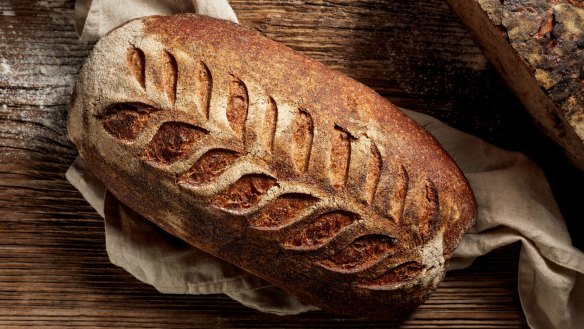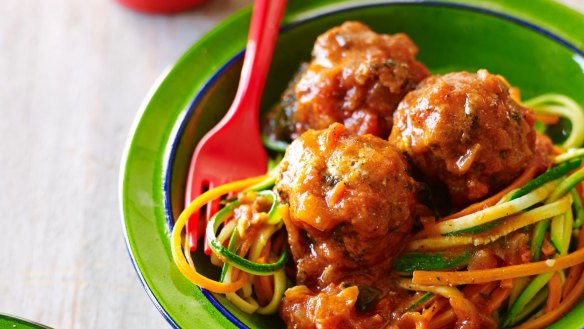A beginners' guide to understanding gluten

Updated , first published

- Low-FODMAP meal planner: Six tasty tummy-friendly recipes
- It might not be the gluten making you bloated
- Gluten-free meal planner
Gluten tends to get a bad rap lately. It's become the poster boy for fad diets, and a headache for the modern-day chef or home cook.
But does it deserve its reputation as the bad boy of baking? And who really needs to avoid it, anyway?

For starters – what even is gluten? And why does it leave some people lurching in pain, while others escape unscathed? Let's break down the basics.
What is gluten?
According to Coeliac Australia, gluten is a collective term for proteins found in grains such as wheat, rye, and triticale (a cross between wheat and rye). It's what gives dough its stickiness and stretch, and makes sourdough deliciously elastic. Oats contain a similar protein called avenin, and may be contaminated with wheat or other grains during storage or harvest, so cannot be labelled "gluten-free" in Australia.
As more and more research is done we're able to add to the evidence base.
Who can – and can't – eat gluten?
For most people, gluten is perfectly safe to eat. In general, health professionals "like to keep people's diets as varied as possible", says Natasha Murray, an accredited practising dietitian and spokeswoman for the Dietitians Association of Australia.
You should only avoid gluten or certain gluten-containing foods if your doctor has diagnosed you with one of the following conditions, Murray says. They often share symptoms such as bloating, pain, wind and altered bowel habits so can be easily confused without proper diagnosis.
Coeliac disease is a serious autoimmune disease that affects at least one in 70 Australians. When gluten is ingested, it damages the small intestine and prevents the body from absorbing nutrients. This can lead to fatigue, anaemia and other problems including weight loss if undiagnosed or untreated, Murray says. Diagnosis is made by a doctor through biopsy or blood test. The condition has a strong genetic component, and is managed with a strict gluten-free diet. While many people with coeliac disease can tolerate oats uncontaminated by wheat and other grains, this can only be confirmed by a separate biopsy so people with coeliac disease should generally avoid oats, Murray says.
Dermatitis herpetiformis is a chronic skin condition associated with coeliac disease. According to Coeliac Australia, it is intensely itchy even when it appears as a fine rash but may present as small bumps, scaly skin or a hive-like rash. It is not contagious and is unrelated to dermatitis or herpes. "People are born with a genetic predisposition to develop coeliac disease and/or DH," the organisation's website says. "Less than 10 per cent of patients with DH will also have the gastrointestinal symptoms associated with coeliac disease. However, biopsies show that people with DH will have some degree of villous atrophy (small bowel damage) on consumption of a high gluten load." Diagnosis is made via skin biopsy by a dermatologist. The condition is managed in the same way as coeliac disease, by a strict gluten-free diet, in conjunction with oral medication to relieve the itch.
Non-coeliac gluten sensitivity (NCGS) can cause the same general symptoms as coeliac disease such as pain, bloating and wind, but it does not damage the body in the same way, Murray says. It is a "diagnosis of exclusion", which means a doctor must first rule out coeliac disease and other conditions such as inflammatory bowel disease (Crohn's or colitis), she explains. The condition is best managed with a strict gluten-free diet – but patients can be assured that accidentally eating gluten won't harm their gut, Murray says.
Irritable bowel syndrome (IBS) is a common condition that alters digestive motility and affects about one in seven Australian adults. Diagnosis is often based on symptoms such as bloating, abdominal pain and wind, in conjunction with a food diary, after doctors have ruled out more sinister conditions such as coeliac disease or cancer. The condition is generally managed through a short-term food plan that limits trigger foods. The low-FODMAP diet, as it's known, restricts foods high in short-chain carbohydrates called Fermentable Oligosaccharides, Disaccharides, Monosaccharides, And Polyols – food groups that tend to be poorly absorbed in the small intestine, especially in large quantities. Common culprits include garlic, onion, milk, legumes, stone fruit – and yes, rye and wheat. While lots of information is available online it's essential to consult an accredited practising dietitian before trying the plan, Murray says. They can help you figure out which food groups you can reintroduce safely in the long term and make sure all your nutritional and fibre needs are met. "It is a long process but can be very, very effective," she says. Confusion often crops up because the low-FODMAP diet limits (but does not completely exclude) some gluten-containing foods such as wheat. Unless someone has been diagnosed with coeliac disease or gluten sensitivity, the culprit is more likely to be fructans, a type of carbohydrate found in wheat and some other high-FODMAP foods, Murray says. Conversely, some gluten-free foods can also be high in FODMAPS – for example, chickpeas.
A food allergy (for example, to wheat) causes more immediate immune system reactions to foods, ranging from hives, stomach upset and wheezing to life-threatening anaphylaxis. Usually diagnosed by a doctor via skin prick allergy test or allergy blood test.
The research frontier
One of the reasons the area can be so confusing to understand is that much of the research in the field is still relatively new and is therefore subject to constant change, Murray says. The causes and mechanisms of the conditions are also not yet fully understood.
"As more and more research is done we're able to add to the evidence base and refine our recommendations and findings as well," she says.
Non-coeliac gluten sensitivity is one area that's proven contentious. Dr Emma Halmos, an accredited practising dietitian from Monash University and The Alfred Hospital, says the most recent research from Australia and Norway shows the condition is either extremely rare or may in fact be confused with other conditions.
"These studies showed that most people who consider themselves as having NCGS respond to not gluten, but other components of wheat, including FODMAPS," she says.
"What this means is that many people are likely blaming the wrong thing and may be misdiagnosing themselves with NCGS, when in fact they may have IBS or another functional condition."
In the kitchen
If you are diagnosed with coeliac disease or non-coeliac gluten sensitivity, it helps to follow a few rules of thumb, Murray says.
If one person in a family is diagnosed, she suggests the whole family go gluten-free to avoid accidental cross-contamination, especially where young children are involved.
Murray also suggests cooking gluten-free items before starting any gluten-containing recipes.
Labelled containers or a colour-coding system are other options but whatever method you adopt, it's essential all utensils, plates and surfaces (including toasters and shared items such as butter) remain entirely gluten-free and do not physically touch any gluten-containing foods, Murray says.
"Washing with soap and warm water is all that's needed," she says.
Ben Milbourne, cookbook author and presenter of SBS TV series Food Lab, recommends sticking to the basics when you first go gluten-free.
Most items in the meat and produce aisle are naturally free of gluten, so a plate of protein and veg is an easy option for beginners.
Once you gain a little confidence, Milbourne suggests experimenting with gluten substitutes such as gluten-free flours and pastas.
Their quality has improved greatly in recent years, meaning you don't need to miss out on the joys of baking (and eating) cake and other comfort carbs, he says.
It's also important to check labels and ask questions when shopping and eating out as gluten often sneaks into sauces, dressings, stocks or cooking oil.
The trick is to understand why you are using gluten and find a suitable substitute, Milbourne says. For example, cornflour is a good gluten-free alternative if you're trying to thicken a sauce. And rather than opting for chewy or stretchy baked goods such as croissants, try dense, nutty and seedy breads and crackers.
"Instead of creating a poor version of sourdough try ... something a little bit dense," Milbourne says.

Ben Milbourne's gluten-free chicken veloute recipe
INGREDIENTS
10 chicken wings/drumsticks
1 tbsp olive oil
1 leek, chopped
2 celery, chopped
4 sprigs thyme, chopped
¾ cup sherry
50g butter
1 litre gluten-free chicken stock
250g creme fraiche
4 sprigs parsley
½ lemon, juiced
1 pinch sea salt
2 sprigs chervil
Method
1. Add chicken to a hot oiled pan and leave to cook.
2. After a few minutes add leek, celery and thyme into the pan with and mix together.
3. Pour sherry into pan and add a flame to pan to flambe it before adding in butter, stock, creme fraiche, parsley, lemon juice and salt and leaving to simmer for about 10 minutes.
4. After 10 minutes, strain chicken and serve in a bowl with a drizzle of sauce from the pan, and a few sprigs of chervil on top.
Serves 3
Food Lab by Ben Milbourne series 3 will air on weekdays at 5pm on SBS Food starting on Monday, March 18.
The best recipes from Australia's leading chefs straight to your inbox.
Sign upMore:
From our partners
Original URL: https://www.brisbanetimes.com.au/goodfood/tips-and-advice/a-beginners-guide-to-understanding-gluten-20190312-h1cb19.html